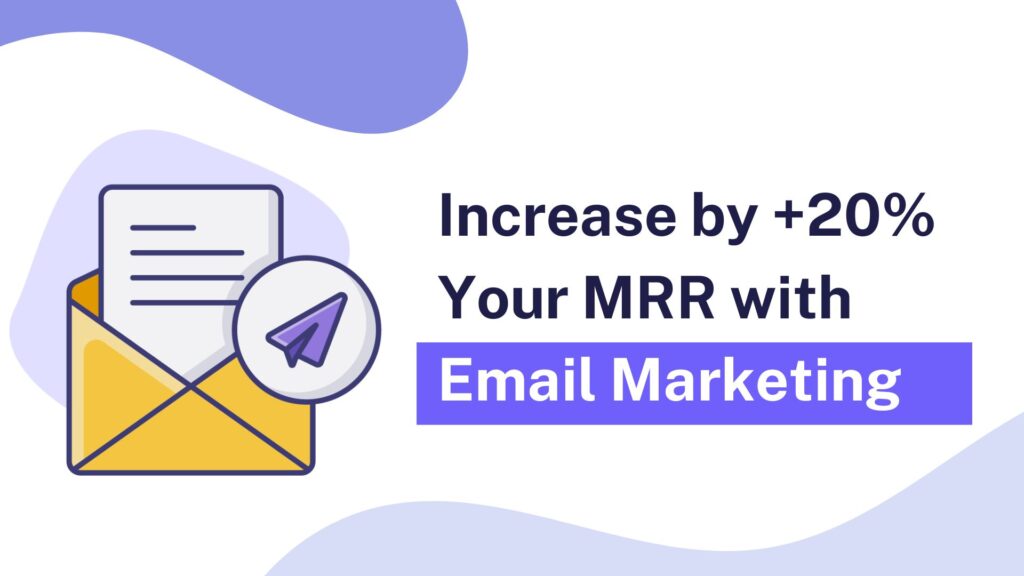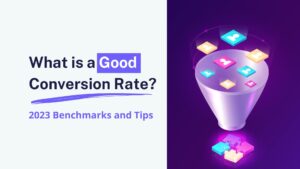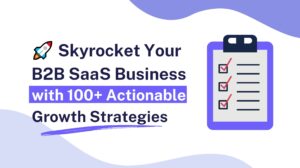Did you know that with the right strategy, email marketing can be a powerhouse for your B2B SaaS business? With the power to reach your target audience at any stage of the customer journey, email marketing is a proven way to nurture relationships, convert leads, and drive growth. But how can you use it effectively? This comprehensive guide will help you understand the importance of a strong email marketing strategy and walk you through crafting your own.
Table of Contents
The Impact of Email Marketing on MRR
In the digital era, a sound email marketing strategy is more crucial than ever. Emails offer an intimate, direct line of communication between your business and your clients, positioning your message right in their inboxes. It also has an impressive ROI, with every $1 spent on email marketing generating $42 in return.
A well-crafted email marketing strategy can significantly bolster your Monthly Recurring Revenue (MRR), a key performance indicator for B2B SaaS companies. Here’s how.
Driving Prospects Down the Funnel
Email marketing is a cost-effective way of moving prospects further down the sales funnel. With the right content, you can nurture leads, turning them from just interested prospects to loyal customers. It’s an opportunity to showcase your product’s value, answer queries, address concerns, and guide them towards making a purchase, all without incurring significant additional costs.
Conversion Rates in Email Marketing
The power of email marketing is evident in its conversion rates. According to industry statistics, the average conversion rate from lead to user through email marketing is approximately 3.26%.
The rate from user to paying customer can vary widely based on the product and industry, but it can reach up to 5.19%. These figures underline the potential of email marketing in improving MRR.
Crafting Your B2B SaaS Email Marketing Strategy
The secret sauce to a great email marketing strategy lies in the details. It’s not enough to just send emails; you must carefully plan, target, and customize them to effectively reach your audience.
- Identify Your Email Lists
Your email list is the backbone of your email marketing strategy. Identifying your list involves compiling the contact details of current clients, leads, and prospects who have expressed interest in your product or service. This could be through form submissions, downloads, or sign-ups on your website.
- Segment Your List Based on Customer Journey / Funnel
Segmentation is the process of dividing your email list into smaller groups based on specific criteria, such as where they are in the customer journey. This enables you to send more targeted, relevant emails to your audience, boosting engagement and conversions.
- Sketch Up a Strategy for Each Stage
Every stage in the customer journey requires a unique approach. By understanding where your prospects are and what they need, you can tailor your messaging to meet their expectations and guide them towards conversion.
- Current Awareness: At this stage, your potential customers are aware of a problem they have and are seeking solutions. Your emails should aim to educate and inform, providing valuable content that positions your SaaS product as a potential solution.
- Objective: Determine the next step for your customer. Should they download a free trial? Schedule a demo? Define clear calls to action for each stage.
- Value Proposition: Think about what would be valuable to your customers at each stage. Early in the funnel, it might be educational content, while later it could be a free trial or discount.
- Set Timing and Numbers
Getting the timing right can significantly increase your email marketing success. Consider factors like when your audience is most likely to check their emails and how often they’d like to hear from you. Quality over quantity is key; it’s better to send fewer, more valuable emails than to bombard your audience with too many messages.
TIP: Follow the 80/20 Rule
When building your email marketing strategy, apply the Pareto Principle, also known as the 80/20 rule. Prioritize your efforts on the stages where you can achieve 80% of the results with just 20% of your effort. This will ensure you maximize your impact without overwhelming yourself or your team.
Understanding Your Audience: The Customer Journey
A successful email marketing strategy requires a deep understanding of your audience and their journey. This involves knowing your customers’ needs, behaviors, and pain points at each stage of the funnel, allowing you to create content that resonates and engages.
B2B SaaS Funnels / Models
B2B SaaS companies typically utilize one of three models: free trial, freemium, or free demo. Each requires a different approach in terms of email marketing.
- Free Trial: This model allows users to test your full product for a limited time. Your email strategy here should focus on encouraging users to sign up for the trial, then providing them with resources to make the most out of it.
- Freemium: With this model, users get access to basic features of your product for free and can pay for additional features. Emails should highlight the benefits of upgrading to a paid plan.
- Free Demo Call: A demo lets prospects see your product in action before making a purchase. Emails should encourage scheduling a demo and then follow up to move them towards conversion.
Segmentations Based on Behavior
Segmenting your list based on behavioral data allows you to further personalize your email marketing. Here are some possible segments:
- Newsletter Subscribers: These are individuals who have opted in to receive regular updates from your company.
- Lead Magnet Subscribers: These subscribers have shown interest in your content, making them warm leads.
- Free Trial / Freemium Users: Active users are already engaging with your product, while inactive ones may need encouragement to get started.
- Demo Participants: Those who have scheduled or completed a demo are further along in the funnel and may be ready to make a purchase.
- Paid Users: These are your current customers, who you should aim to retain and possibly upsell.
- Loyal Customers: Your most loyal customers can become advocates for your brand, so consider strategies to nurture these relationships.
Make A/B Testing to Improve Conversions
A/B testing is a crucial component of a successful email marketing strategy. Here’s how to leverage this tool to drive conversions and enhance your B2B SaaS business.
Track Your Numbers
Measuring and analyzing the performance of your emails is foundational to A/B testing. Here are the key metrics to monitor:
- Open Rates: This measures how many recipients open your emails. Low open rates may indicate issues with your subject lines or sender name.
- Click-Through Rates: This calculates the percentage of recipients who clicked on a link within your email. A low click-through rate could signify that your email content isn’t resonating with your audience.
- Conversion Rates: This metric represents the percentage of recipients who took a desired action, such as signing up for a trial or purchasing a product. Low conversion rates might indicate a disconnect between your email content and your offer.
- Bounce Rates: This is the percentage of emails that weren’t delivered to the recipient’s inbox. High bounce rates could mean there are invalid email addresses on your list.
Experiment with Different Approaches
Different audiences respond to different communication styles. Consider these approaches in your A/B testing:
- Personal vs. Professional Tone: Personal tones are friendly and conversational, while professional tones are formal and business-like. Test to see which your audience prefers.
- Short vs. Long Emails: Some recipients might prefer brief, to-the-point emails, while others appreciate comprehensive, detailed content.
- Test Call-to-Action (CTA) Placement: The location of your CTA in the email can influence click-through rates. Try placing it at the beginning, middle, and end of your emails.
Play With The Content
Shaking things up in your email content can help you break through the clutter of your recipients’ inboxes. Many other companies are sending emails to your customers. Try to break the pattern to shine through the darkness. Experiment with:
- Engaging Subject Lines: Subject lines greatly impact open rates. Test different styles, like question-based subject lines, personalization, or ones that create a sense of urgency.
- Unique Visuals: Images and videos can significantly increase engagement. Try using custom graphics, GIFs, infographics, or even embedded videos.
- Interactive Elements: Quizzes, polls, or clickable infographics can encourage recipient interaction and increase engagement.
Send Surveys
Surveys can provide critical insights into your audience’s preferences and the effectiveness of your email strategy.
- Feedback on Email Sequences: Ask recipients what they think about your email sequence. Are the emails helpful? Is the frequency right? Use the feedback to optimize your strategy.
- Product Improvement Surveys: Request feedback about your product or service. This can not only help improve your offering but also demonstrate to customers that you value their opinions.
Best Email Marketing Software Recommendations
Choosing the right email marketing software is crucial for the success of your SaaS email marketing strategy. It should not only fit your budget but also cater to your specific needs and goals. Here are our top five recommendations:
1. Mailchimp
Mailchimp is a user-friendly email marketing tool that is perfect for businesses just starting out with email marketing. It offers pre-designed templates, automation features, segmentation, and comprehensive analytics. Its robust integration capabilities mean you can connect it with your existing CRM, ecommerce, and other systems.
2. HubSpot
HubSpot is an all-in-one marketing software that goes beyond just email marketing. It allows you to create, automate, and measure email campaigns, and it also includes CRM, landing pages, social media, and analytics.
3. Sendinblue
Sendinblue is an excellent choice for businesses that prioritize transactional emails and SMS messages along with their email marketing campaigns. It offers a robust free plan, and the paid plans are more generous than most competitors in terms of the number of emails you can send.
4. ActiveCampaign
ActiveCampaign is a feature-rich email marketing tool that comes with advanced automation, segmentation, and personalization capabilities. It also offers CRM and sales automation, making it an excellent choice for businesses looking to enhance their sales processes.
5. ConvertKit
ConvertKit is a powerful email marketing tool designed specifically for bloggers, content creators, and small businesses, but is really useful for SaaS companies too. It emphasizes simplicity and ease-of-use, but it also has robust capabilities like visual automation workflows, personalized emails, and comprehensive subscriber management. If you are starting out it can meet all your needs.







